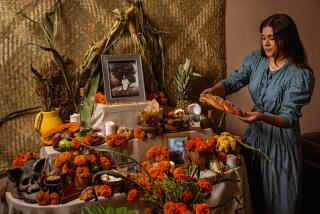Om Is Where the Hearth Is
- Share via
On her parents’ former backgammon table in a light-filled corner of the living room, actress, filmmaker and sometime psychic Lucinda Clare keeps a panoply of gods. A resin-red Buddha, Ganesh and Lakshmi keep company with a photo of a Parisian cancan girl lying on a velvet sofa, a pack of worn tarot cards, a Tibetan prayer bag and tiny bottles holding a rainbow of pigments and aura sprays. “It’s my creativity altar,” she explains.
Clare has more than half a dozen personal altars scattered throughout her hillside home. The accompanying candles, flowers, burning incense and crystals represent the fire, water, air and earth elements.
Intentions are written down and placed in the center of the altars--her wishes for her career, a baby, world peace, creativity--where they are released to the universe. “I’m covering all my bases,” says the daughter of an Irish Catholic father and Church of England mother.
The age-old tradition of home altars is on the rise. They have a long history among Christians and followers of Buddhism and Hinduism, says Jeffrey H. Mahan, dean of faculty at the Iliff School of Theology in Denver. “There’s much more fluidity and freedom to mine multiple spiritual traditions today. Individuals take from each what they need. Home altars represent a kind of spiritual buffet.”
Although some personal shrines spring up around objects people love, others follow more formal principles. Robin and Michael Mastro, leading experts of Vastu Shastra--the ancient architectural science of creating environmental harmony and personal growth (think Indian feng shui)--say their Seattle-based business creating altars, homes and offices based on those principles has doubled in the last two years. Their book, “Altars of Power and Grace,” has sold more than 10,000 copies.
“There’s always been a natural inclination to create an environment where people go to honor the forces of nature,” says Robin. “We’re also in a time in our culture when we are feeling less connected. There’s a desire to be joined to something higher and not to feel that we’re so alone. Altars are a wonderful avenue to connect us with the spiritual.”
Silk Roads Design Gallery owners Jon and Cari Markell agree. Business is brisk for Buddhist and devotional art in their striking La Brea Avenue emporium filled with the fragrance of temple incense and the sounds of Tibetan singing bowls. People of all religious persuasions--Catholics, Presbyterians and Jews who adopt Buddhism or think along Buddhist lines--he says are shopping for home altar accouterments.
“People are perceiving the world as scary and spending more time at home,” explains Jon. “They want to create a safe, spiritual and calming space. It’s a place to connect heart and brain before going out to deal with the world.”
The owners, both raised as Jews, have set up their home altar atop a built-in 1940s vanity. From their bed they can gaze upon a gold-leaf Burmese Buddha meditation board; a rare wood Buddha-as-baby; the Balinese goddess of fertility, Dewi Sri; and portraits of loved ones. “We didn’t place the objects in any particular order,” says Jon. “It’s a family thing; we just like to look at them.”
Former advertising executive and environmentalist Peter Stranger’s altar consists of objects picked up on wilderness walks around the world--antlers and birds’ feathers from the Hollywood Hills, a baby hippo’s tooth from Botswana--as well as personal items such as a photo of his beloved ridgeback Kaya and a ceramic bowl his son made. The only god figure is Ganesh, the Indian elephant god of overcoming obstacles, a gift from friend Robin Mastro, who applied Vastu Shastra principles to Stranger’s once-spontaneously arranged altar.
Stranger’s wife, Camille, a writer, tends a pair of altars. Fresh fruit and flowers from her garden are added daily to her spirituality shrine in a corner of her kitchen. At her career altar in her office, Jesus and Mary statues, inherited from her Catholic grandparents, keep company with photos of modern-day saints she met on a trip to India. “When I finish writing a piece, or if I’m stuck on a particular story, I place it on the altar. It’s all about inspiration and support.”
Songwriter Jan Edwards of West Hollywood, who grew up attending the Church of Christ with her grandmother as well as a Reform Jewish temple, loves that there are no rules attached to having an altar or connecting with the spiritual. She begins each day with a cup of tea in front of hers. Randomly selecting a morning meditation from her decks of Gita and dream interpretation cards has become a ritual establishing her “blueprint for the day.”
“For me, the altar is an adult space that’s safe--like having a tent when you were a kid,” she says.
*
(BEGIN TEXT OF INFOBOX)
Creating Your Own Altar
*
Statues: Antique Buddhas and other devotional art, at Silk Roads Design Gallery, Los Angeles, (323) 857-5588.
Music: Ancient meditation music from around the world, at www.spasong.com.
Books: “The Way of Vastu” and “Altars of Power and Grace,” both by Robin and Michael Mastro, at www.balancedbookspub.com.
Daily Inspiration: Meditative thought for the day for healing mind, body and spirit at www.DailyOM.com.
Inspirational cards: The Gita, Wisdom From the Bhagavad Gita, Toltec Wisdom and Messages from Your Angels, at Bodhi Tree Book Store, West Hollywood, (310) 659-1733.
Ritual items: Tibetan prayer flags, bells and mala beads at www.dharmashop.com.
Vastu Shastra environmental designers: Robin and Michael Mastro, Office of Vastu Creations, Seattle, (206) 328-0122; www.vastucreations.com.
*
“If we launch a new project, my husband and I light a candle, sit and hold hands and humbly offer our intentions to the universe. We keep a copy of our business plan under the altar--to help grow the business.”
--Madisyn Taylor
*
“When friends Michael and Robin Mastro came for a visit, they turned my collection of loved things into an actual altar. Collections tend to sit there, but when they added fire (candle), earth (amethyst), water (flower) and air (incense) elements according to Vastu principles, it became organic and vital. It feels like a living presence in the room.”
--Camille Stranger
*”I love being in the wilderness. The altar grew organically from a collection of objects from my travels and walks that appealed to me. Their presence brings the wilderness inside and reminds me of the natural order of things. They inspire my work.”
--Peter Stranger


